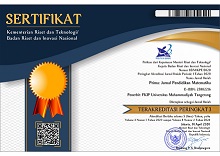THE STUDENT’S ENHANCEMENT OF MULTIPLE REPRESENTATION ABILITY USING MERRILL’S FIRST PRINCIPLES OF INSTRUCTION
Abstract
A learning process in schools realizes the purpose of this education. Mathematical multi representation ability is one of the general goals of teaching mathematics in schools. This research is quasi-experimental. The amount of increase before and after learning is calculated by the normalized gain formula. There is a difference in the increase in mathematical multi-representation abilities of students who receive MFPI learning than conventional learning based on high KAM and medium early mathematical ability. By contrast, at low early mathematical ability, there is no difference in increasing multi representation abilities. Most students use mathematical representations. The percentage of students using more than two representations is 40%. MFPI learning affects students with high and medium KAM but does not affect students with low early mathematical ability. Because at the MFPI learning stage, low early mathematical ability students lack initial knowledge that can be used to form new knowledge.
Keywords
Full Text:
PDFReferences
Ainsworth, S. (1999). The Functions of Multiple Representations. Computers & Education, 33(2–3), 131–152.
Angel, C., Kind, P., Henriksen, E., & Guttersrud, Q. (2008). An Empirical-Mathematical Modeling Approach To Upper Secondary Physics. Physics Education, 43(3), 256–264.
Apriani, C. M. (2016). Analisis Representasi Matematis Siswa SMP Dalam Memecahkan Masalah Matematika Kontekstual. Skripsi Tidak Diterbitkan (Hlm. 1–81). Yogyakarta: Universitas Sanata Dharma.
Bezemer, J., & Kress, G. (2008). Writing In Multimodal Texts: A Social Semiotic Account Of Designs For Learning. Written Communication, 25(2), 166–195.
Cai, J., & Hwang, S. (2002). Generalized and Generative Thinking In the US and Chinese Students' Mathematical Problem Solving and Problem Posing. The Journal of Mathematical Behavior, 21(4), 401–421.
Hake, R. R. (1999). Analyzing change/gain scores. Indiana University.
Kusumah, E. C. (2016). Peningkatan Kemampuan Representasi Matematis Siswa melalui Model Means-Ends Analysis dalam Pembelajaran Matematika. Universitas Pendidikan Indonesia.
Lesh, R., Post, T. R., & Behr, M. (1987). Representations and Translations Among Representations In Mathematics Learning and Problem Solving. In Problems of representations in the teaching and learning of mathematics (pp. 33–40). Lawrence Erlbaum.
Nopitasari, D. (2017). Analisis Kemampuan Multi Representasi Matematis Berdasarkan Kemampuan Awal Matematis Mahasiswa. Pedagogy: Jurnal Pendidikan Matematika, 2(1).
Smaldino, S. E., Lowther, D. L., Russell, J. D., & Mims, C. (2008). Instructional Technology and Media for Learning. Pearson Merrill Prentice Hall Upper Saddle River, NJ.
Suryowati, E. (2015). Kesalahan Siswa Sekolah Dasar dalam Merepresentasikan Pecahan pada Garis Bilangan. Aksioma: Jurnal Program Studi Pendidikan Matematika, 4(1).
Wilujeng, H., Kusumah, Y. S., & Darhim, D. (2019). The Students’ Achievement of Algebraic Thinking Ability Using Merrill’s First Principles of Instruction. Journal of Physics: Conference Series, 1188(1), 12039.
DOI: http://dx.doi.org/10.31000/prima.v6i1.5167
Article Metrics
Abstract - 1598 PDF - 1299Refbacks
- There are currently no refbacks.
Prima: Jurnal Pendidikan Matematika
Program Studi Pendidikan Matematika
Fakultas Keguruan dan Ilmu Pendidikan
Universitas Muhammadiyah Tangerang
Jl. Perintis Kemerdekaan I/33, Cikokol
Kota Tangerang, Indonesia
e-mail: primajpm@gmail.com
Prima: Jurnal Pendidikan Matematika (p-ISSN: 2579-9827 | e-ISSN: 2580-2216) is licensed under a Creative Commons Attribution 4.0 International License.







